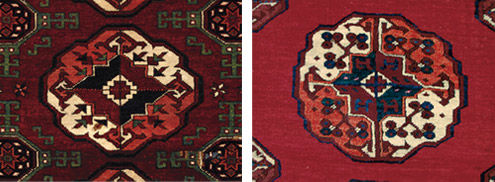In addition to livestock, the most important Turkmen family possession was the housing unit: a fabric-covered domed tent fashioned from slender wooden poles that were tied together with rope each time it was erected. The dome of the wooden frame was covered with large, thick slabs of felt that were secured with fabric bands. The felt allowed for ventilation and protection from water during rare rainstorms.
The primary furnishing of the tent was a large carpet (known as a main carpet) that covered most of the floor, though less affluent families may have used felt floor coverings. Additional carpets served as doors and exterior decoration. The Turkmen hung storage bags filled with clothing, cooking utensils, bread, and tent pegs on the walls. The faces of these bags were woven in warm colors and elaborate patterns incorporating abstracted floral motifs, called gul (fig. 44), which are particular to each tribe and tribal subgroup. These textiles served both functional and decorative purposes in the Turkmen dwelling (fig. 45).

Fig. 44. Comparison of the Arabatchi (detail, image 39) and Salor (detail, 1974.149.46) guls in the Museum's collection

Fig. 45. A Turkmen family, about 1910–15
| Previous Section | Next Section |